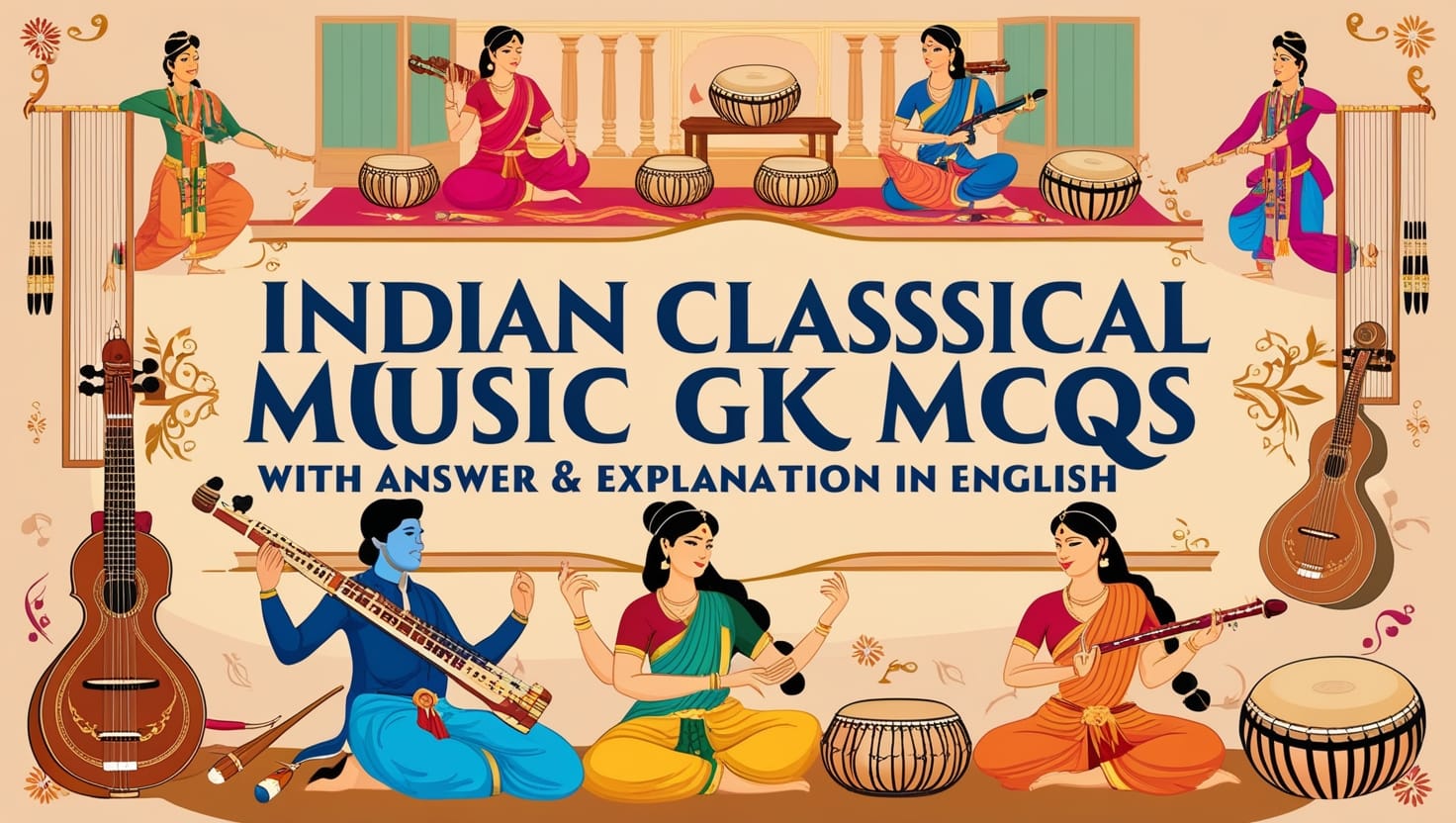
Indian classical music is a rich and timeless tradition that forms the foundation of the country’s cultural and artistic heritage. This article, titled Indian Classical Music GK MCQs With Answer & Explanation in English, provides a comprehensive set of multiple-choice questions designed to test and enhance your knowledge of this intricate art form.
With detailed answers and explanations, you can explore the nuances of Hindustani and Carnatic music, legendary musicians, and the diverse ragas and talas that define this classical treasure. Perfect for learners and enthusiasts alike!
1. Bobbili veena, also known as Saraswathi Veena or the Ekanda Veena, is a large plucked string instrument used in Carnatic classical music. It is made from which of the following trees?
- Sandalwood
- Jackwood
- Bamboo
- Rosewood
Show Answer
Answer: Jackwood
The Bobbili Veena, also known as Saraswathi Veena or Ekanda Veena, is a traditional Indian musical instrument. It is primarily associated with the Carnatic music tradition of South India. What sets the Bobbili Veena apart is that it is carved from a single piece of jackwood, a tree native to rainforests. This craftsmanship results in a resonant and melodious sound. The instrument is named after the town of Bobbili in Andhra Pradesh, where it has been traditionally crafted and is celebrated for its artistry.
2. Thumri Singer Girija Devi belongs to which among the following Gharanas?
- Banaras Gharana
- Agra Gharana
- Kirana Gharana
- Lucknow Gharana
Show Answer
Answer: Banaras Gharana
Girija Devi was a prominent thumri singer in the field of Hindustani classical music. She belonged to the Banaras Gharana, a renowned musical lineage. Thumri is a form of light classical music known for its emotive and romantic themes. Girija Devi was celebrated for her exceptional performances in thumri, which she delivered with grace and emotion. Her contributions to Indian classical music made her an iconic figure in the realm of thumri.
3. Who among the following is considered to be the originator of the khayal and tarana styles of Hindustani Classical Music?
- Niyamat Khan
- Mohammad Shah Rangile
- Amir Khusro
- Tansen
Show Answer
Answer: Amir Khusro
Amir Khusro, a Sufi mystic and scholar who lived during the 13th century, is recognized for his significant contributions to Hindustani classical music. He was a disciple of Nizamuddin Auliya, a revered Sufi saint. Amir Khusro is credited with originating the khayal and tarana styles in Hindustani classical music. The khayal style is characterized by the use of Persian and Arabic musical elements and was an innovative development in Indian music. Tarana, another style he introduced, uses syllables as a form of vocal percussion and rhythm in compositions.
4. Pandit Jasraj belongs to which among the following Gharanas?
- Kirana
- Jaipur
- Banaras
- Mewati
Show Answer
Answer: Mewati
Pandit Jasraj was a highly acclaimed Indian classical vocalist known for his significant contributions to music. He belonged to the Mewati Gharana, which is one of the prominent gharanas (musical lineages) in Indian classical music. Over his musical career of more than 75 years, Pandit Jasraj showcased his mastery of vocal techniques and was celebrated for his melodious renditions, earning him numerous accolades and honors.
5. The terms Udara, Mudara, and Tara are related to which among the following as per the ancient Indian texts?
- Medicines
- Gods
- Music
- Military science
Show Answer
Answer: Music
Udara, Mudara, and Tara are important terms in the context of Indian music. These terms are associated with the connotations of music in ancient Indian texts. They refer to different registers or ranges of musical notes, with Udara representing the lower register, Mudara representing the middle register, and Tara representing the higher register. These divisions help in classifying musical notes and creating a comprehensive framework for understanding and organizing Indian classical music.
6. Dr M Balamuralikrishna was a renowned artist of_____________?
- Hindustani Vocal
- Carnatic Vocal
- Dhrupad Style
- Carnatic Instrumental
Show Answer
Answer: Carnatic Vocal
Dr. M. Balamuralikrishna was a renowned Carnatic vocalist from the state of Tamil Nadu, India. He was a prolific musician and composer, known for his extraordinary vocal skills and innovative approach to music. Dr. Balamuralikrishna’s contributions to Carnatic music included creating new ragas and composing a wide range of compositions in various languages. He was a musical genius who left a lasting impact on the world of Indian classical music.
7. Bageshwari Qamar is a woman player of which of the following music instruments?
- Ghatam
- Shehnai
- Pakhawaj
- Santoor
Show Answer
Answer: Shehnai
Bageshwari Qamar is a notable female artist who plays the shehnai, a traditional Indian wind instrument. The shehnai is particularly associated with North Indian classical music and is often played during various ceremonial and festive occasions, such as weddings and religious events.
8. In the context of Indian music, Abhang are the devotional songs dedicated to which among the following gods?
- Jagannatha
- Narayana
- Vitthala
- Vamana
Show Answer
Answer: Vitthala
Abhang is a devotional and poetic form of music that is dedicated to the Hindu deity Vitthala, a form of Lord Krishna. Sant Tukaram, a revered saint and poet from Maharashtra, India, is credited with composing the earliest Abhangs. These devotional songs are an integral part of bhakti (devotional) traditions and are sung in praise of Lord Vitthala.
9. Gundecha brothers are well-known exponents of which among the following styles of Hindustani Classical Music?
- Khayal
- Tharana
- Dhrupad
- Thumri
Show Answer
Answer: Dhrupad
The Gundecha Brothers are celebrated exponents of Dhrupad, one of the oldest forms of North Indian classical music. They belong to the Dagar vani, a school of Dhrupad music known for its rich and austere style. The Gundecha Brothers have received numerous awards and accolades for their contributions to preserving and promoting the Dhrupad tradition.
10. In which century was Hindustani music diverged from the Carnatic tradition, making a separate gharana in Classical Music?
- 11th century CE
- 12th century CE
- 13th century CE
- 14th century CE
Show Answer
Answer: 12th century CE
Hindustani classical music and Carnatic music are two distinct and prominent traditions of Indian classical music. Hindustani music, which primarily evolved in North India, is characterized by a greater influence of Persian and Islamic musical elements. The divergence of Hindustani classical music from the Carnatic tradition is believed to have occurred around the 12th century CE, leading to the development of its unique gharanas (musical lineages) and styles.







